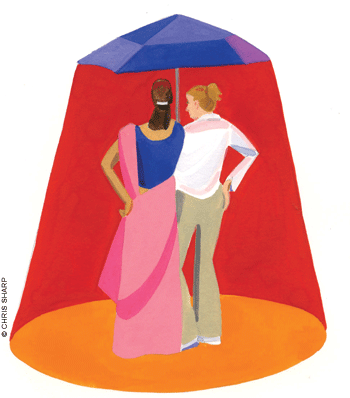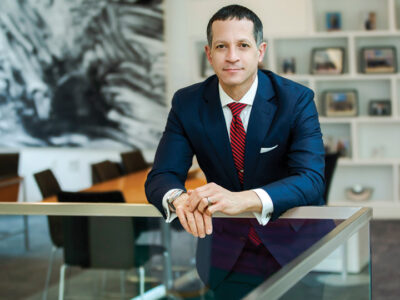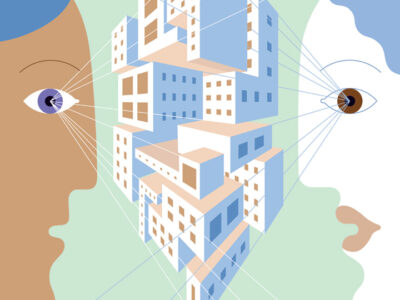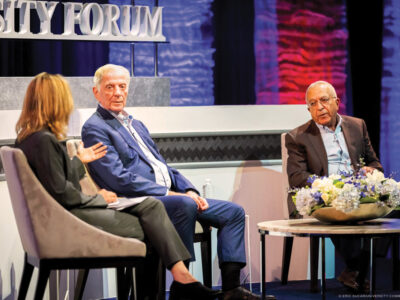
“I’ll take the intrepid amongst you,” said Toorjo Ghose, the gentle, long-haired assistant professor in the School of Social Policy and Practice (SP2), to a group of students in the winter of 2010. “Because we’re going to have to work it out as we go along.”
Seven students, all women, all finishing up their first year of the master’s of social work program, accepted his challenge. And so began a mind-expanding journey, and a new approach to the oldest profession.
At first glance, the course description for Postcolonial Social Work Practice: International Social Welfare in India might not seem that unusual. The class “examines the global social-welfare system and its engagement with marginalized communities such as sex workers in India,” the blurb notes, and is designed to give students an understanding of the “complicated relationship between social control and social change embedded in welfare initiatives in postcolonial conditions.”
But this isn’t the usual academic experience: “During the six-week course in Kolkata [Calcutta], students will complete a placement in a sex-workers’ collective in Sonagachi, one of Asia’s largest red-light districts.”
The oldest profession is a salient fact of life in India, where hundreds of thousands of sex workers ply their trade in dangerous and often degrading conditions. HIV is a constant, menacing presence; physical abuse is common; and the stigma of their trade has meant that the workers seldom get justice for crimes against them and that even their children are ostracized.
Yet while the rate of HIV infection among sex workers in cities such as Mumbai, Delhi, and Chennai ranges from 50 to 90 percent, in Kolkata the rate is just 11 percent—and, as one sex worker told Ghose: “Now I’m proud to tell people about my work.” That difference has been widely credited to the Sonagachi Project, which since 1992 has been mobilizing sex workers to use condoms, engage in HIV education, form community-based organizations, and advocate for themselves. Started as a condom-education program by the Durbar Mahila Samanwaya Committee (DMSC, a union and community organization that includes some 60,000 sex workers), the Sonagachi Project runs healthcare clinics, a savings and banking co-op, a dance-drama troupe, a support group for HIV-positive sex workers, and even schools for sex-workers’ children. (For those who blanch at the term sex workers, that’s what the women themselves prefer, since the other names tend to be a lot more derogatory.)
Ghose knows the Sonagachi district well, and not just as an academic.
“I’m from Kolkata, and that neighborhood was always something I was very familiar with,” he says. “I have a lot of friends who are in the sex-work industry. It’s never been a tremendously stigmatized community for me because I actually know people who are in it.”
By the time he began studying the Sonagachi Project as a graduate student at UCLA eight or nine years ago, it was already a very successful enterprise.
“A lot of people were looking at it as a medical intervention,” says Ghose. “But the social-worker perspective really examines the cultural, ecological, social determinants of health. It wasn’t just about HIV. It was collective identity; it was working around the stigma of sex work; it was negotiating politically with the outside world.”
When he came to Penn four years ago, Ghose continued studying and writing about Sonagachi. Research has a catalytic effect on his teaching, he notes, and “every time I reached for a good example to explain to students why we are a little different from other ‘helping professions,’ Sonagachi kept coming up. It was a wonderful way to explain there was this whole context around health that, as social workers, we needed to reengage with. And every time I presented my work, the students became very engaged.” He soon concluded that the next time he went, he needed to bring some students, an idea that dovetailed nicely with SP2’s increasingly international scope.
What Ghose did not want to do was “recreate the old colonial practices, of engaging from a very elite institution such as Penn, going into a poor community and telling people what to do.
“The concept of collaborating with the agency and the community, which the students were forced to do in India, really translates well here in West Philadelphia,” he adds. And at the top of that collaborative spirit is “asking the community what they consider important.”
The students were placed with the DMSC, and would observe and interact with sex workers, their children, and their families. They would also read up on postcolonial theory, take classes, and do research projects. But Ghose wasn’t kidding when he said they’d have to make it up as they went along in this very foreign and challenging environment.
“One of the [student’s] comments was: ‘We were very frustrated by how little guidance there was sometimes,’” Ghose says cheerfully. But, he adds, the students eventually came to realize that the relative lack of structure had been a blessing in disguise. “They said, ‘We are not intimidated by differences anymore. Even when we don’t know the language or culture we’ll be able to communicate and learn by ourselves.’ So that level of confidence, working across class and culture, was huge for them.”
Some challenges were visceral: India’s poverty and sex industry are not for the faint-hearted.
“The first days brought a wave of emotions I was not prepared for,” wrote one student. “I was sure that I would not be able to handle the experiences to come.”
The language barrier proved especially ticklish. The problem was not just that the students didn’t speak Bengali, but that their interpreters often translated certain key words in very different ways.
“One of the concepts that everybody struggled with was trafficking, a concept that has huge implications,” says Ghose, noting that one interpreter translated the word to mean crossing state lines to sell one’s wares, while another relegated it to those who were under-aged. Eventually the frustrated students “made that one of the focal points of the course—the concept of translation interpretation,” says Ghose. “It was a huge theory issue, and it gave rise to a wonderful mini-conference. They were really categorizing the typology of trafficking.”
Safety turned out not to be an issue, since the students were always accompanied by members of the sex-workers union, who not only protected them but gave them an extremely warm welcome.
“What really threw the students was the open-armed kind of reception the community had for them,” says Ghose. “Partly because they’re such a stigmatized community, they were really welcoming.”
After the students had been “exposed to such a level of advocacy from people who one could easily write off as being at the bottom rung of the social ladder,” says Ghose, they “uniformly said they were just overwhelmed by how strong these women were, and how uncompromising they were in their identity as working women.”
As Ghose’s research indicates, the sex workers have a low opinion of traditional institutions—religion, schools, even hospitals—that had stigmatized and ostracized them and their families. Many of the women “feel that religion will do nothing for us,” one woman told Ghose in a 2008 article for Social Science & Medicine, while another noted that she “couldn’t convince the teachers that my son was an appropriate student for their good school—all because of my profession.” Another reported that when she was found to be HIV-positive after giving birth, no one would touch her and the nurses would throw her baby onto her lap. (“The hospital authorities killed my baby,” she added bitterly.)
“I call it the politics of the pragmatic,” says Ghose. “It’s survival politics that really infuses their very complicated understanding of religion, class, and gender. I argue in a paper that this is the new social movement in India. It’s pointing towards the way in which marginalized communities jump over the divide [between] civil society and the community that is not served by civil-society institutions. It’s as marginalized as you can get. But they are extremely powerful now.
“And that’s important for social workers to see!” he adds with a rueful laugh. “You know, we get so beaten down by the hopelessness of the situation sometimes that it’s fascinating to see how spectacularly successful it can be when it works.”
“Every day and every conversation about my time in Kolkata brings new reflection and understanding,” wrote one student. “It is a process that I do not expect to end.”
Nor will the implications for social work closer to home.
“Some of our research findings about [the DMSC’s] advocacy efforts seem surprisingly relevant [with respect to] organizing in the United States,” wrote one student. “Many of the barriers to advocacy identified by sex workers—such as family obligations and financial difficulties—are frequently cited reasons for lack of civic and political engagement in the US.”
And far from feeling exploited, the DMSC has posted some of the students’ comments on its website and is using their research as something “to build on,” says Ghose. “The students really did us proud, I think. They’re remembered very fondly. The union is very primed to receive the next group of students.”
That will be this summer, when Ghose takes a group of 14 more students to Kolkata. —S.H.




